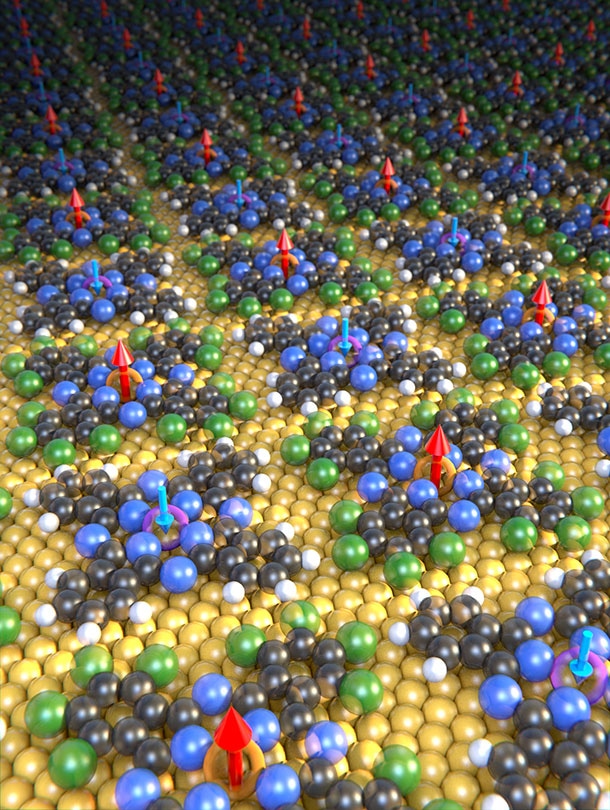May 23 2017
 Phthalocyanines with iron (orange) and manganese (violet) centers co-assemble on a gold surface into a checkerboard pattern. The magnetism of iron and manganese differs in strength and points in opposite directions (red and blue arrows), fulfilling the prerequisites for extremely, atomically thin ferrimagnets. (Image: University of Basel, Department of Physics)
Phthalocyanines with iron (orange) and manganese (violet) centers co-assemble on a gold surface into a checkerboard pattern. The magnetism of iron and manganese differs in strength and points in opposite directions (red and blue arrows), fulfilling the prerequisites for extremely, atomically thin ferrimagnets. (Image: University of Basel, Department of Physics)
Two-dimensional (2D) magnetic structures are believed to be a promising material for new types of data storage, as the magnetic properties of individual molecular building blocks can be examined and altered.
Recently, researchers have created a wafer-thin ferrimagnet for the first time, in which molecules with varied magnetic centers arrange themselves on a gold surface to form a checkerboard pattern. Researchers at the Swiss Nanoscience Institute at the University of Basel and the Paul Scherrer Institute published their findings in the Nature Communications journal.
Ferrimagnets are made up of two centers which are magnetized at varying strengths and point in opposing directions. Quasi-flat, 2D ferrimagnets would be ideal for use as data storage devices, sensors, or in a quantum computer, since the 2D arrangement allows the magnification state of each atom or molecule to be selected. For geometrical and mathematical reasons, however, it has until now not been possible to create 2D ferrimagnets.
Choice of materials makes the impossible possible
The researchers in Professor Thomas Jung’s research groups at the Paul Scherrer Institute (PSI) and the Department of Physics at the University of Basel have currently found a technique for developing a 2D ferrimagnet.
The researchers initially produce “phthalocyanines” – hydrocarbon compounds with different magnetic centers made up of manganese and iron. When these phthalocyanines are applied to a gold surface, they position themselves into a checkerboard pattern in which molecules with manganese and iron centers alternate. The team was able to prove that the surface is magnetic and that the magnetism of the manganese and iron is of varying strengths and appears in opposing directions – all features of a ferrimagnet.
The decisive factor of this discovery is the electrically conductive gold substrate, which mediates the magnetic order. Without the gold substrate, the magnetic atoms would not sense each other and the material would not be magnetic.
Dr. Jan Girovsky, PSI, University of Basel
The key effect of the conducting electrons in the gold substrate is revealed by a physical effect detected in each magnetic atom using scanning tunnel spectroscopy. The experiments were done at different temperatures and thus provide proof of the strength of the magnetic coupling in the new magnetic material. Model calculations established the experimentally observed effect and specified that special electrons attached to the surface in the gold substrate are in charge for this type of magnetism.
Nanoarchitecture leads to new magnetic materials
“The work shows that a clever combination of materials and a particular nanoarchitecture can be used to produce new materials that otherwise would be impossible,” says Professor Nirmalya Ballav of the Indian Institute of Science Education and Research in Pune (India), who has been examining the properties of molecular nano-checkerboard architectures for a number of years with Jung. The magnetic molecules have immense potential for several applications, since their magnetism can be separately examined and also altered using scanning tunnel spectroscopy.